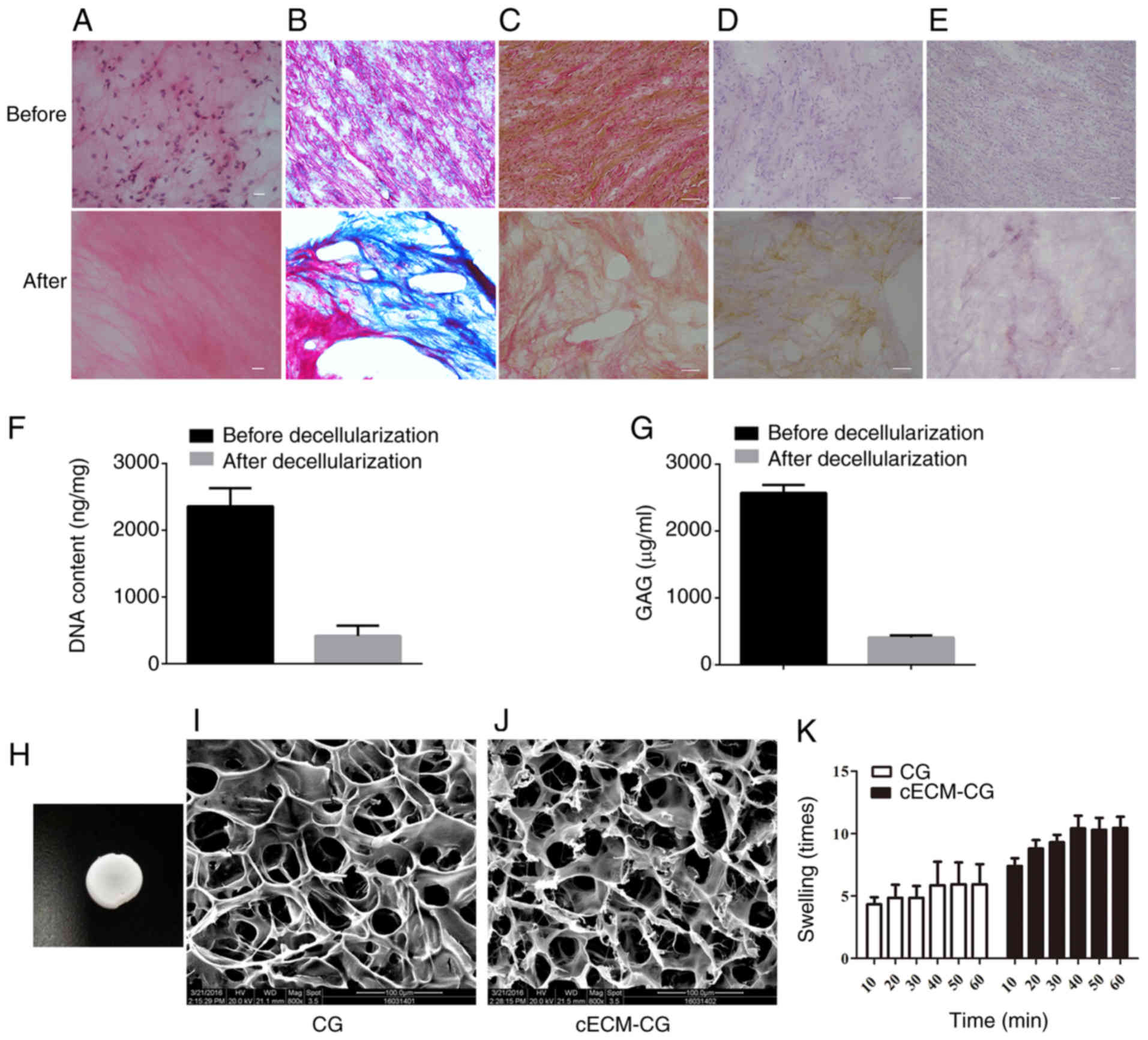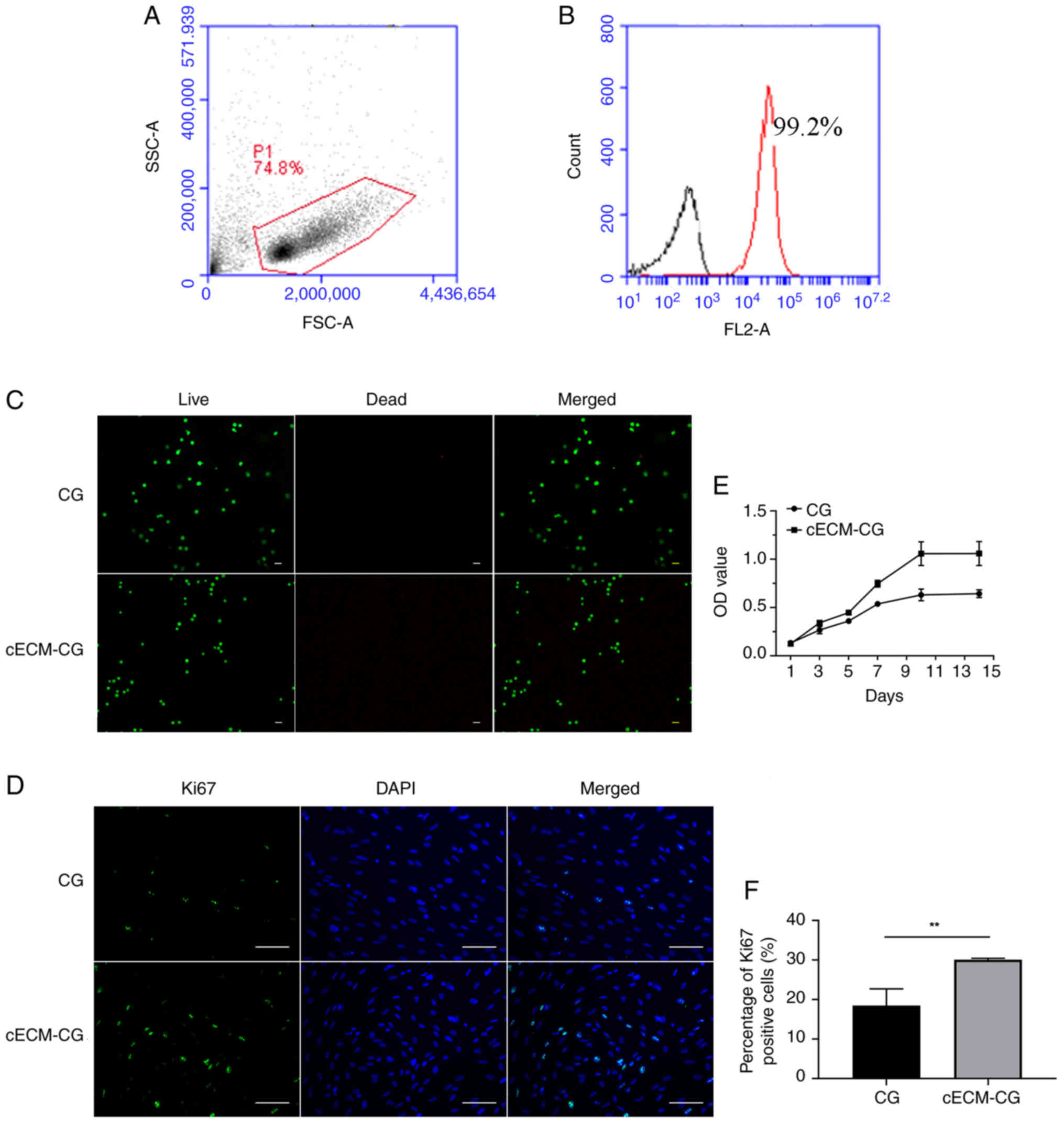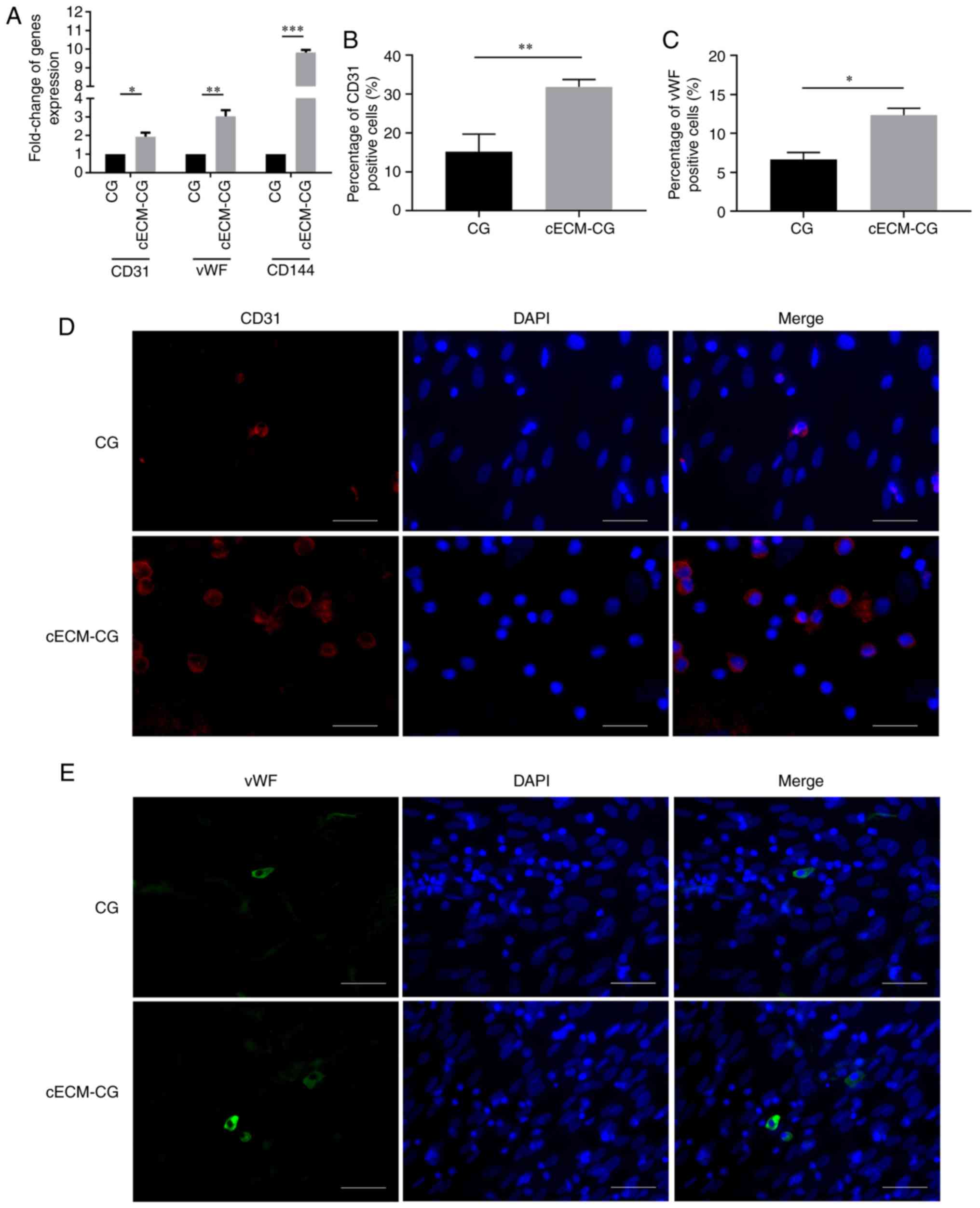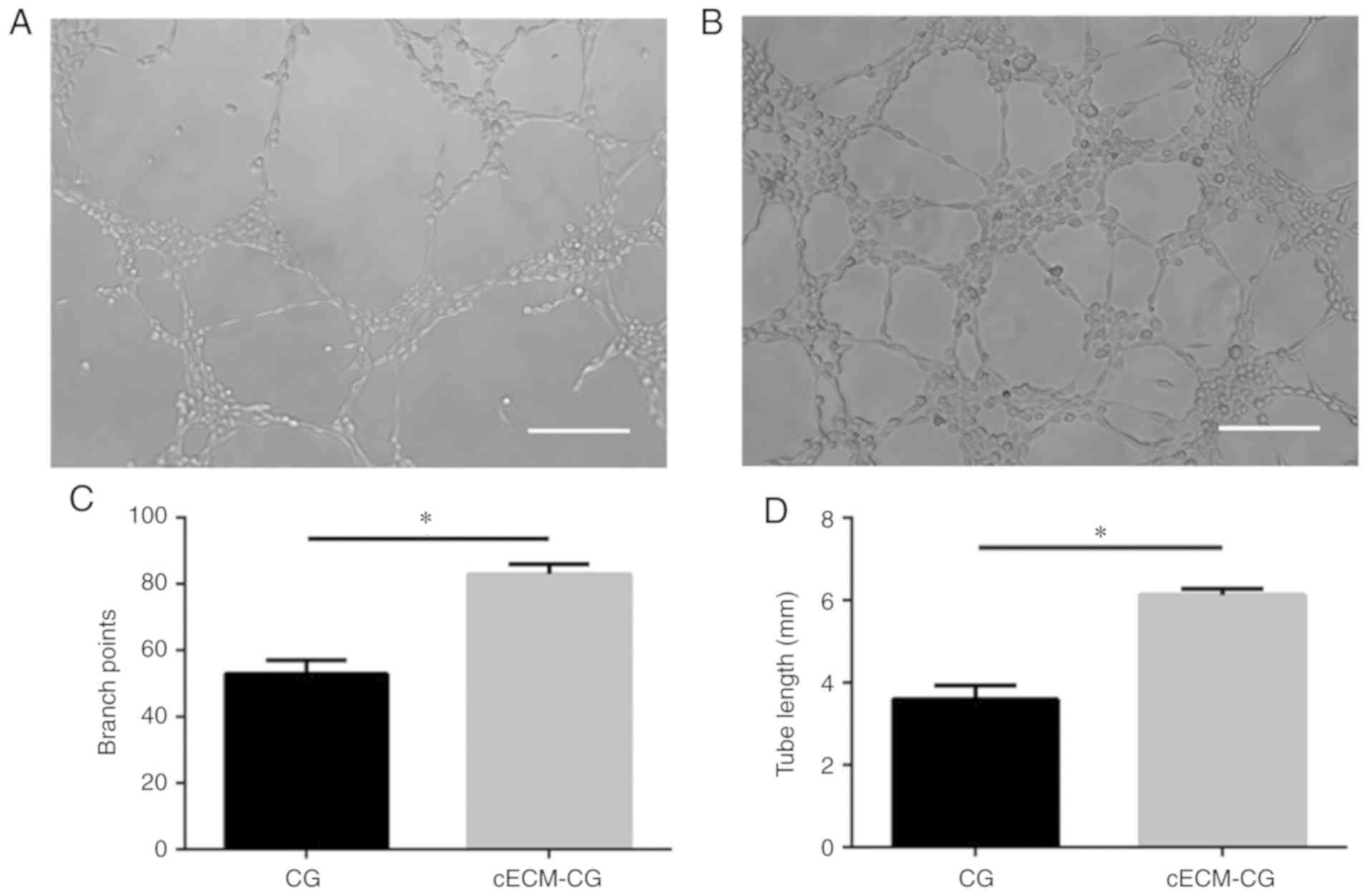|
1
|
Benjamin EJ, Muntner P, Alonso A,
Bittencourt MS, Callaway CW, Carson AP, Chamberlain AM, Chang AR,
Cheng S, Das SR, et al: Heart disease and stroke statistics-2019
update: A report from the American heart association. Circulation.
139:e56–e528. 2019. View Article : Google Scholar : PubMed/NCBI
|
|
2
|
Tsilimigras DI, Oikonomou EK, Moris D,
Schizas D, Economopoulos KP and Mylonas KS: Stem cell therapy for
congenital heart disease: A systematic review. Circulation.
136:2373–2385. 2017. View Article : Google Scholar : PubMed/NCBI
|
|
3
|
Kochupura PV, Azeloglu EU, Kelly DJ,
Doronin SV, Badylak SF, Krukenkamp IB, Cohen IS and Gaudette GR:
Tissue-engineered myocardial patch derived from extracellular
matrix provides regional mechanical function. Circulation. 112
(Suppl 9):I144–I149. 2005.PubMed/NCBI
|
|
4
|
Mosala Nezhad Z, Poncelet A, Fervaille C
and Gianello P: Comparing the host reaction to CorMatrix and
different cardiac patch materials implanted subcutaneously in
Growing Pigs. Thoracic Cardiovasc Surg. 67:44–49. 2019. View Article : Google Scholar
|
|
5
|
Nishida H, Nakatsuka D, Kawano Y, Hiraiwa
N, Takanashi S and Tabata M: Outcomes of totally endoscopic atrial
septal defect closure using a glutaraldehyde-treated autologous
pericardial patch. Circ J. 81:689–693. 2017. View Article : Google Scholar : PubMed/NCBI
|
|
6
|
Lee C, Lim HG, Lee CH and Kim YJ: Effects
of glutaraldehyde concentration and fixation time on material
characteristics and calcification of bovine pericardium:
Implications for the optimal method of fixation of autologous
pericardium used for cardiovascular surgery. Interact Cardiovasc
Thorac Surg. 24:402–406. 2017.PubMed/NCBI
|
|
7
|
Rieder E, Steinacher-Nigisch A and Weigel
G: Human immune-cell response towards diverse xenogeneic and
allogeneic decellularized biomaterials. Int J Surg. 36:347–351.
2016. View Article : Google Scholar : PubMed/NCBI
|
|
8
|
Spadaccio C, Chello M, Trombetta M, Rainer
A, Toyoda Y and Genovese JA: Drug releasing systems in
cardiovascular tissue engineering. J Cell Mol Med. 13:422–439.
2009. View Article : Google Scholar : PubMed/NCBI
|
|
9
|
Anderson DEJ, Truong KP, Hagen MW, Yim EKF
and Hinds MT: Biomimetic modification of poly(vinyl alcohol):
Encouraging endothelialization and preventing thrombosis with
antiplatelet monotherapy. Acta Biomater. 86:291–299. 2019.
View Article : Google Scholar : PubMed/NCBI
|
|
10
|
Shoji T and Shinoka T: Tissue engineered
vascular grafts for pediatric cardiac surgery. Transl Pediatr.
7:188–195. 2018. View Article : Google Scholar : PubMed/NCBI
|
|
11
|
Mantakaki A, Fakoya AOJ and Sharifpanah F:
Recent advances and challenges on application of tissue engineering
for treatment of congenital heart disease. PeerJ. 6:e58052018.
View Article : Google Scholar : PubMed/NCBI
|
|
12
|
Afewerki S, Sheikhi A, Kannan S, Ahadian S
and Khademhosseini A: Gelatin-polysaccharide composite scaffolds
for 3D cell culture and tissue engineering: Towards natural
therapeutics. Bioeng Transl Med. 4:96–115. 2018. View Article : Google Scholar : PubMed/NCBI
|
|
13
|
Thein-Han WW, Saikhun J, Pholpramoo C,
Misra RD and Kitiyanant Y: Chitosan-gelatin scaffolds for tissue
engineering: Physico-chemical properties and biological response of
buffalo embryonic stem cells and transfectant of GFP-buffalo
embryonic stem cells. Acta Biomater. 5:3453–3466. 2009. View Article : Google Scholar : PubMed/NCBI
|
|
14
|
Pok S, Myers JD, Madihally SV and Jacot
JG: A multilayered scaffold of a chitosan and gelatin hydrogel
supported by a PCL core for cardiac tissue engineering. Acta
Biomater. 9:5630–5642. 2013. View Article : Google Scholar : PubMed/NCBI
|
|
15
|
Silva AC, Rodrigues SC, Caldeira J, Nunes
AM, Sampaio-Pinto V, Resende TP, Oliveira MJ, Barbosa MA,
Thorsteinsdóttir S, Nascimento DS and Pinto-do-Ó P:
Three-dimensional scaffolds of fetal decellularized hearts exhibit
enhanced potential to support cardiac cells in comparison to the
adult. Biomaterials. 104:52–64. 2016. View Article : Google Scholar : PubMed/NCBI
|
|
16
|
Yi S, Ding F, Gong L and Gu X:
Extracellular matrix scaffolds for tissue engineering and
regenerative medicine. Curr Stem Cell Res Ther. 12:233–246. 2017.
View Article : Google Scholar : PubMed/NCBI
|
|
17
|
Scholl FG, Boucek MM, Chan KC, Valdes-Cruz
L and Perryman R: Preliminary experience with cardiac
reconstruction using decellularized porcine extracellular matrix
scaffold: Human applications in congenital heart disease. World J
Pediatr Congenit Heart Surg. 1:132–136. 2010. View Article : Google Scholar : PubMed/NCBI
|
|
18
|
Wang X, Yu T, Chen G, Zou J, Li J and Yan
J: Preparation and characterization of a
Chitosan/Gelatin/Extracellular Matrix Scaffold and its application
in tissue engineering. Tissue Eng Part C Methods. 23:169–179. 2017.
View Article : Google Scholar : PubMed/NCBI
|
|
19
|
Tian Y and Liu Y: Preparation and
evaluation of extracellular matrix scaffold of human adipose
tissue. Zhonghua Zheng Xing Wai Ke Za Zhi. 33:129–135. 2017.(In
Chinese). PubMed/NCBI
|
|
20
|
Stoppel WL, Hu D, Domian IJ, Kaplan DL and
Black LD III: Anisotropic silk biomaterials containing cardiac
extracellular matrix for cardiac tissue engineering. Biomed Mater.
10:0341052015. View Article : Google Scholar : PubMed/NCBI
|
|
21
|
Shell DH IV, Croce MA, Cagiannos C,
Jernigan TW, Edwards N and Fabian TC: Comparison of
small-intestinal submucosa and expanded polytetrafluoroethylene as
a vascular conduit in the presence of gram-positive contamination.
Ann Surg. 241:995–1004. 2005. View Article : Google Scholar : PubMed/NCBI
|
|
22
|
Porzionato A, Stocco E, Barbon S, Grandi
F, Macchi V and De Caro R: Tissue-engineered grafts from human
decellularized extracellular matrices: A systematic review and
future perspectives. Int J Mol Sci. 19(pii): E41172018. View Article : Google Scholar : PubMed/NCBI
|
|
23
|
Chemla ES and Morsy M: Randomized clinical
trial comparing decellularized bovine ureter with expanded
polytetrafluoroethylene for vascular access. Br J Surg. 96:34–39.
2009. View Article : Google Scholar : PubMed/NCBI
|
|
24
|
Pok S, Benavides OM, Hallal P and Jacot
JG: Use of myocardial matrix in a chitosan-based full-thickness
heart patch. Tissue Eng Part A. 20:1877–1887. 2014. View Article : Google Scholar : PubMed/NCBI
|
|
25
|
Pok S, Stupin IV, Tsao C, Pautler RG, Gao
Y, Nieto RM, Tao ZW, Fraser CD Jr, Annapragada AV and Jacot JG:
Full-thickness heart repair with an engineered multilayered
myocardial patch in rat model. Adv Healthc Mater. 6:2017.doi:
10.1002/adhm.201600549. View Article : Google Scholar : PubMed/NCBI
|
|
26
|
Bunting S, Moncada S and Vane JR:
Antithrombotic properties of vascular endothelium. Lancet.
2:1075–1076. 1977. View Article : Google Scholar : PubMed/NCBI
|
|
27
|
Walter DH, Rittig K, Bahlmann FH,
Kirchmair R, Silver M, Murayama T, Nishimura H, Losordo DW, Asahara
T and Isner JM: Statin therapy accelerates reendothelialization: A
novel effect involving mobilization and incorporation of bone
marrow-derived endothelial progenitor cells. Circulation.
105:3017–3024. 2002. View Article : Google Scholar : PubMed/NCBI
|
|
28
|
Urbich C and Dimmeler S: Endothelial
progenitor cells: Characterization and role in vascular biology.
Circ Res. 95:343–353. 2004. View Article : Google Scholar : PubMed/NCBI
|
|
29
|
Werner N, Priller J, Laufs U, Endres M,
Böhm M, Dirnagl U and Nickenig G: Bone marrow-derived progenitor
cells modulate vascular reendothelialization and neointimal
formation: Effect of 3-hydroxy-3-methylglutaryl coenzyme a
reductase inhibition. Arterioscler Thromb Vasc Biol. 22:1567–1572.
2002. View Article : Google Scholar : PubMed/NCBI
|
|
30
|
Hirashima M, Kataoka H and Nishikawa S,
Matsuyoshi N and Nishikawa S: Maturation of embryonic stem cells
into endothelial cells in an in vitro model of vasculogenesis.
Blood. 93:1253–1263. 1999. View Article : Google Scholar : PubMed/NCBI
|
|
31
|
Aoki J, Serruys PW, van Beusekom H, Ong
AT, McFadden EP, Sianos G, van der Giessen WJ, Regar E, de Feyter
PJ, Davis HR, et al: Endothelial progenitor cell capture by stents
coated with antibody against CD34: The HEALING-FIM (healthy
endothelial accelerated lining inhibits neointimal growth-first in
man) registry. J Am Coll Cardiol. 45:1574–1579. 2005. View Article : Google Scholar : PubMed/NCBI
|
|
32
|
French KM, Boopathy AV, DeQuach JA,
Chingozha L, Lu H, Christman KL and Davis ME: A naturally derived
cardiac extracellular matrix enhances cardiac progenitor cell
behavior in vitro. Acta Biomater. 8:4357–4364. 2012. View Article : Google Scholar : PubMed/NCBI
|
|
33
|
Livak KJ and Schmittgen TD: Analysis of
relative gene expression data using real-time quantitative PCR and
the 2(-Delta Delta C(T)) method. Methods. 25:402–408. 2001.
View Article : Google Scholar : PubMed/NCBI
|
|
34
|
Olmer R, Engels L, Usman A, Menke S, Malik
MNH, Pessler F, Göhring G, Bornhorst D, Bolten S,
Abdelilah-Seyfried S, et al: Differentiation of human pluripotent
stem cells into functional endothelial cells in scalable suspension
culture. Stem Cell Reports. 10:1657–1672. 2018. View Article : Google Scholar : PubMed/NCBI
|
|
35
|
Zhang Y, Fan W, Ma Z, Wu C, Fang W, Liu G
and Xiao Y: The effects of pore architecture in silk fibroin
scaffolds on the growth and differentiation of mesenchymal stem
cells expressing BMP7. Acta Biomater. 6:3021–3028. 2010. View Article : Google Scholar : PubMed/NCBI
|
|
36
|
Miyagi Y, Chiu LL, Cimini M, Weisel RD,
Radisic M and Li RK: Biodegradable collagen patch with covalently
immobilized VEGF for myocardial repair. Biomaterials. 32:1280–1290.
2011. View Article : Google Scholar : PubMed/NCBI
|
|
37
|
Shi C, Li Q, Zhao Y, Chen W, Chen B, Xiao
Z, Lin H, Nie L, Wang D and Dai J: Stem-cell-capturing collagen
scaffold promotes cardiac tissue regeneration. Biomaterials.
32:2508–2515. 2011. View Article : Google Scholar : PubMed/NCBI
|
|
38
|
Fu JH, Zhao M, Lin YR, Tian XD, Wang YD,
Wang ZX and Wang LX: Degradable chitosan-collagen composites seeded
with cells as tissue engineered heart valves. Heart Lung Circ.
26:94–100. 2017. View Article : Google Scholar : PubMed/NCBI
|
|
39
|
Ropcke DM, Ilkjaer C, Tjornild MJ, Skov
SN, Ringgaard S, Hjortdal VE and Nielsen SL: Small intestinal
submucosa tricuspid valve tube graft shows growth potential,
remodelling and physiological valve function in a porcine model†.
Interact Cardiovasc Thorac Surg. 24:918–924. 2017. View Article : Google Scholar : PubMed/NCBI
|
|
40
|
Efraim Y, Sarig H, Cohen Anavy N, Sarig U,
de Berardinis E, Chaw SY, Krishnamoorthi M, Kalifa J, Bogireddi H,
Duc TV, et al: Biohybrid cardiac ECM-based hydrogels improve long
term cardiac function post myocardial infarction. Acta Biomater.
50:220–233. 2017. View Article : Google Scholar : PubMed/NCBI
|
|
41
|
Meyer SR, Nagendran J, Desai LS, Rayat GR,
Churchill TA, Anderson CC, Rajotte RV, Lakey JR and Ross DB:
Decellularization reduces the immune response to aortic valve
allografts in the rat. J Thorac Cardiovasc Surg. 130:469–476. 2005.
View Article : Google Scholar : PubMed/NCBI
|
|
42
|
Padhi A and Nain AS: ECM in
differentiation: A review of matrix structure, composition and
mechanical properties. Ann Biomed Eng. Sep 4–2019.doi:
10.1007/s10439-019-02337-7 (Epub ahead of print). View Article : Google Scholar : PubMed/NCBI
|
|
43
|
Brown BN and Badylak SF: Extracellular
matrix as an inductive scaffold for functional tissue
reconstruction. Transl Res. 163:268–285. 2014. View Article : Google Scholar : PubMed/NCBI
|
|
44
|
Mancuso L, Gualerzi A, Boschetti F, Loy F
and Cao G: Decellularized ovine arteries as small-diameter vascular
grafts. Biomed Mater. 9:0450112014. View Article : Google Scholar : PubMed/NCBI
|
|
45
|
Hutmacher DW: Scaffolds in tissue
engineering bone and cartilage. Biomaterials. 21:2529–2543. 2000.
View Article : Google Scholar : PubMed/NCBI
|
|
46
|
Vane JR and Botting RM:
Endothelium-thromboresistance. Wien Klin Wochenschr. 103:403–404.
1991.PubMed/NCBI
|
|
47
|
Bhattacharya V, McSweeney PA, Shi Q, Bruno
B, Ishida A, Nash R, Storb RF, Sauvage LR, Hammond WP and Wu MH:
Enhanced endothelialization and microvessel formation in polyester
grafts seeded with CD34(+) bone marrow cells. Blood. 95:581–585.
2000. View Article : Google Scholar : PubMed/NCBI
|
|
48
|
Cabanelas N, Martins JD and Pinto F:
Initial use of endothelial progenitor cells capturing stents in
paediatric congenital heart disease. Cardiol Young. 24:900–904.
2014. View Article : Google Scholar : PubMed/NCBI
|
|
49
|
Gao LP, Du MJ, Lv JJ, Schmull S, Huang RT
and Li J: Use of human aortic extracellular matrix as a scaffold
for construction of a patient-specific tissue engineered vascular
patch. Biomed Mater. 12:0650062017. View Article : Google Scholar : PubMed/NCBI
|
|
50
|
Melchiorri AJ, Hibino N and Fisher JP:
Strategies and techniques to enhance the in situ endothelialization
of small-diameter biodegradable polymeric vascular grafts. Tissue
Eng Part B Rev. 19:292–307. 2013. View Article : Google Scholar : PubMed/NCBI
|


















